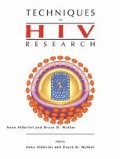Abstract
The infectivity assay is used to titrate virus-containing clarified culture supernatant fluids to determine the 50%-tissue culture infective dose (TCID50) of HIV-1 per ml of original fluid. The ability to measure the amount of infectious virus present in virus-containing fluid is important and useful, particularly for determining the input multiplicity of infection for antiviral experiments [1]. It is a more sensitive and specific assay of virus infectivity than the determination of HIV-1 p24 antigen production or RT activity, as the latter values may also include the measurement of defective virions. This assay can be modified for use with different viral isolates and different cell types.
Access this chapter
Tax calculation will be finalised at checkout
Purchases are for personal use only
Preview
Unable to display preview. Download preview PDF.
References
Hartshorn, K. L., Vogt, M. W., Chou, T.-C., Blumberg, R. S., Byington, R., Schooley, R. T., and Hirsch, M. S. 1987. Synergistic inhibition of human immunodeficiency virus in vitro by azidothymidine and recombinant alpha A interferon. Antimicrob Agents Chemother 31:168–172.
Dulbecco, R. 1988. “End point Method — Measurement of the infectious titer of a viral sample” in the chapter entitled: The Nature of Viruses. In Virology, Second Edition, J. P. Lippincott, Philadelphia, pp. 22–25.
References
Mandel, B. 1979. Interaction of viruses with neutralizing antibodies. In Comprehensive Virology, Vol. 15, H. Fraenkel-Conrat, and R. R. Wagner, eds. Plenum Press, New York, pp. 37–121.
Mandel, B. 1978. Neutralization of animals viruses. Adv Virus Res 23:205.
Dimmock, N. J. 1984. Mechanisms of neutralization of animal viruses. J Gen Virol 65:1015.
Dulbecco, R., Vogt, M., and Stickland, A. G. R. 1956. A study of the basic aspects of neutralization of two animals viruses, western equine encephalitis virus and poliomyelitis virus. Virology 2:162.
Wohlfart, C. 1988. Neutralization of adenoviruses. Stoichiometry and Mechanisms. J Virol 62:2321.
Nara, P. L., Hatch, W. C., Dunlop, N. M., Robey, W. G., Arthur, L. O., Gonda, M. A., and Fischinger, P. J. 1987. Simple, rapid, quantitative syncytium-forming microassay for the detection of human immunodeficiency virus neutralizing antibody. AIDS Res Hum Retroviruses 3:283.
Nara, P. L., and Fischinger, P. J, 1988. Quantitative infectivity assay for HIV-1 and-2. Nature 332:469.
Nara, P. L. 1988. A binding/postbinding event mediated through the gp120 immunodominant epitope. In Retroviruses of Human AIDS and Related Animal Diseases, M. Girad, and L. Valette, eds. Pasteur Vaccines, Paris, pp. 138–150, Ref. ID #278.
Nara, P. L. 1989. HIV-1 neutralization: Evidence for rapid, binding/postbinding neutralization from infected humans, chimpanzees, and gp120-vaccinated animals. In Vaccines 89, Cold Spring Harbor Laboratory, Cold Spring Harbor, NY, pp. 137–144, Ref. ID #135.
Nara, P. L., Huang, K. M., Rausch, D. M., Lifson, J. D., and Eiden, L. E. 1989. CD4 antigen-based antireceptor peptides inhibit infectivity of human immunodeficiency virus in vitro at multiple stages of virus life cycle. Proc Natl Acad Sci USA 86:7139–7143.
Hosoi, S., Borsos, T., Dunlop, N., and Nara, P. L. 1990. Heat-labile, complement-like factor(s) of animal sera prevent(s) HIV-1 infectivity in vitro. JAIDS 3:366–371.
Author information
Authors and Affiliations
Editor information
Editors and Affiliations
Copyright information
© 1990 Stockton Press
About this chapter
Cite this chapter
Johnson, V.A., Byington, R.E., Nara, P.L. (1990). Quantitative Assays for Virus Infectivity. In: Aldovini, A., Walker, B.D. (eds) Techniques in HIV Research. Palgrave Macmillan, London. https://doi.org/10.1007/978-1-349-11888-5_4
Download citation
DOI: https://doi.org/10.1007/978-1-349-11888-5_4
Publisher Name: Palgrave Macmillan, London
Print ISBN: 978-1-349-11890-8
Online ISBN: 978-1-349-11888-5
eBook Packages: MedicineMedicine (R0)

